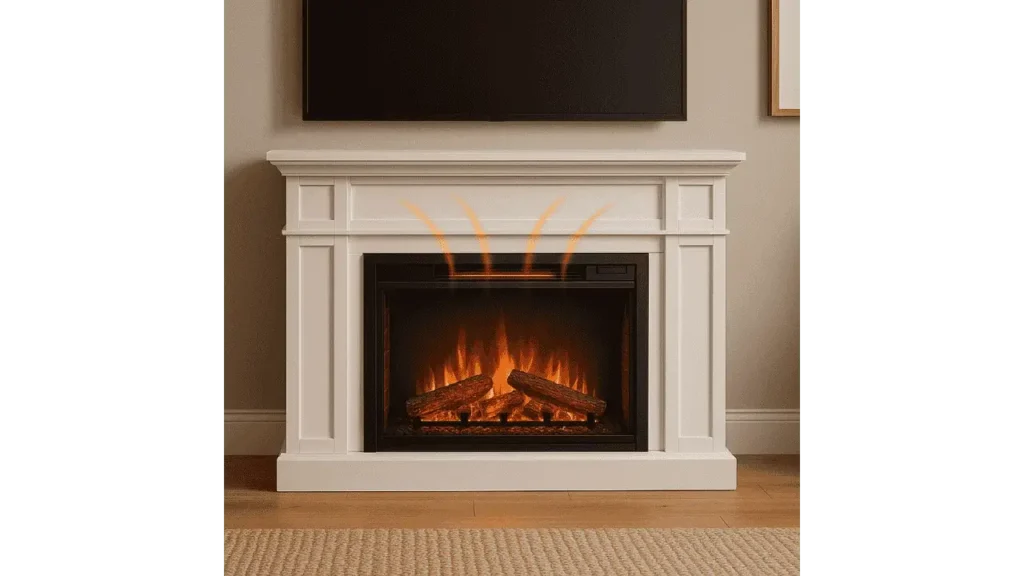“Electric fireplaces are often misunderstood; they’re more than just ambiance,” says Maria Keller, a certified HVAC specialist with over two decades of experience in residential heating systems.
Electric fireplaces do give off heat, and for many homeowners, they provide a reliable source of supplemental warmth. The key is knowing how much heat they produce, how well they perform in different settings, and whether they fit your space. This guide explains exactly how electric fireplaces work, how much warmth to expect, and when they’re the right choice for your home.
Understanding How Electric Fireplaces Work
Heat Without Flames: The Technology Explained
Electric fireplaces use either infrared heating or fan-forced convection systems to distribute heat. Unlike traditional fireplaces, there’s no combustion involved. Instead, they run on electricity and produce heat through metal coils or quartz elements. These components generate warmth without an actual flame, which makes them much safer for indoor use. The flame effect is usually created through LED lighting or projection and operates independently of the heating function, meaning you can enjoy the look even in warmer months. Unlike traditional fireplaces, there’s no combustion involved. Instead, they run on electricity and produce heat through metal coils or quartz elements. The visual flame is separate from the heating function and is often just a projection, so it can operate with or without the heat.
Difference Between Infrared and Fan-Forced Models
Infrared models heat objects and people directly using infrared light, making them efficient for instant warmth. They’re ideal for focused heating, like warming a chair or seating area. Fan-forced models, on the other hand, blow air over a heated coil and circulate it around the room, offering a more uniform spread of warmth. While both types are safe, infrared models tend to feel warmer more quickly, while fan-forced models work better for steady, even room heating over time. using infrared light, making them efficient for instant warmth. Fan-forced models, on the other hand, blow air over a heated coil and circulate it around the room. Both are safe and functional, but infrared tends to feel warmer more quickly in small to medium spaces.
Read More: Can You Change a Gas Fireplace to Electric?
Do All Units Come With Heaters?
Most electric fireplaces include a built-in heating element, but not all do. Some wall-mounted or decorative units focus only on ambiance. Always check the product specs, particularly the BTU rating and wattage, before assuming it can heat your room.
How Much Heat Do Electric Fireplaces Really Produce?
Average BTU Output Compared to Gas and Wood
Electric fireplaces generally range from 4,000 to 5,000 BTUs, which is suitable for warming a 400–500 sq ft area, such as a small living room or bedroom. In contrast, wood-burning fireplaces can exceed 20,000 BTUs, making them suitable for whole-house heating. Gas fireplaces offer a middle ground, often ranging between 8,000 and 15,000 BTUs. Though not as powerful, electric units are perfect for zone heating without the complications of ventilation or emissions, enough to warm a 400–500 sq ft area. In contrast, wood-burning fireplaces can exceed 20,000 BTUs, and gas units fall somewhere in between. Electric fireplaces are not designed to heat your entire home but serve well as a secondary or zone heat source.
Read More: Build an Outdoor Fireplace with a Pizza Oven!
Best Room Sizes for Effective Heating
They work best in smaller rooms like bedrooms, offices, or dens where the heat doesn’t have to travel far. In these enclosed spaces, an electric fireplace can maintain a comfortable temperature without straining its output. Open floor plans or drafty environments can limit their effectiveness, which may require additional insulation or another heat source to maintain warmth throughout the space. Open floor plans or drafty spaces may require a more powerful system or additional insulation to retain heat effectively.
Can They Be Used as Primary Heat Sources?
Technically yes, but not efficiently. Electric fireplaces aren’t designed to replace a full central heating system, especially in colder regions or larger homes. They’re better suited for supplemental heating where targeted warmth is needed. In well-insulated, small to mid-sized rooms, they can help maintain comfort, but relying on them as the sole source of heat may lead to higher electricity costs and inconsistent performance. For daily heating in colder climates, electric fireplaces aren’t the most cost-effective or powerful solution. However, they’re excellent for supplemental heat where a full HVAC boost isn’t necessary.
Just In: Are TV Stands with Fireplaces Safe?
Factors That Affect Heating Performance
Room Size and Insulation
A well-insulated room retains heat much better. The larger and less insulated the space, the harder it is for an electric fireplace to maintain warmth.
Fireplace Wattage and Settings
Most electric fireplaces operate between 1,200 and 1,500 watts. Adjustable thermostats, timers, and fan speeds can influence how efficiently the unit heats.
Placement and Airflow Considerations
Avoid placing the fireplace behind furniture or in blocked corners. Open placement with good airflow allows warm air to circulate freely and evenly.
Benefits of Using Electric Fireplaces for Heat
Safety Compared to Open Flame Units
Electric models produce no real flame or emissions, making them safer for homes with children or pets. The exterior stays cool to the touch, reducing burn risks.
Easy Temperature Control and Zonal Heating
They allow for precise control with remote settings and built-in thermostats. This helps save energy by heating only the room you’re in, instead of the whole house.
Energy Efficiency and Lower Utility Costs
While they don’t match the heat output of gas or wood-burning options, electric fireplaces convert almost all input energy into heat. For occasional or spot heating, they’re efficient and budget-friendly.
Common Misconceptions
They’re Only for Looks
Many assume electric fireplaces are purely decorative. In reality, they can offer real warmth, especially when the right type is chosen.
They Don’t Warm a Room Enough
If matched properly to room size and used correctly, they can comfortably heat small to medium-sized spaces.
All Electric Fireplaces Are the Same
Designs vary widely in heat output, flame technology, and features. Choosing the wrong one for your space or needs can lead to disappointment.
Final Takeaways
Electric fireplaces do give off heat and are more than just pretty decor. While they’re not built to replace a central heating system, they’re a smart, safe, and stylish way to add supplemental warmth to specific rooms. Understanding how they work and choosing the right unit for your space makes all the difference in performance and satisfaction.
- 27 Farmhouse Fireplace Ideas That Bring Warmth & Charm - August 18, 2025
- 25 Fireplace Lighting Ideas to Illuminate Your Hearth - August 7, 2025
- How to Replace an Electric Fireplace Switch? - August 5, 2025



